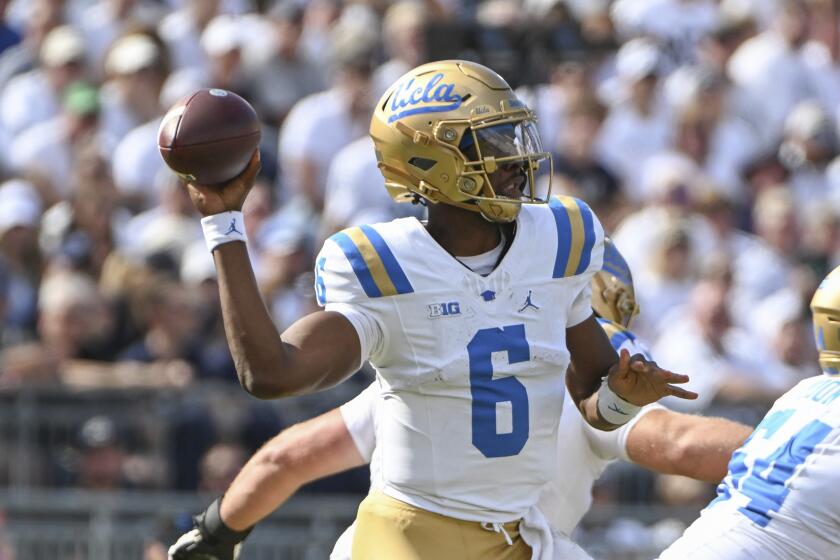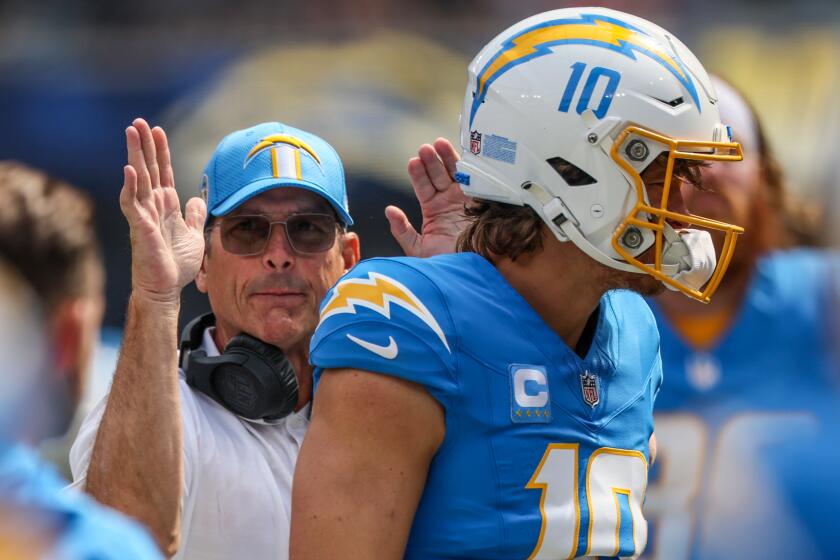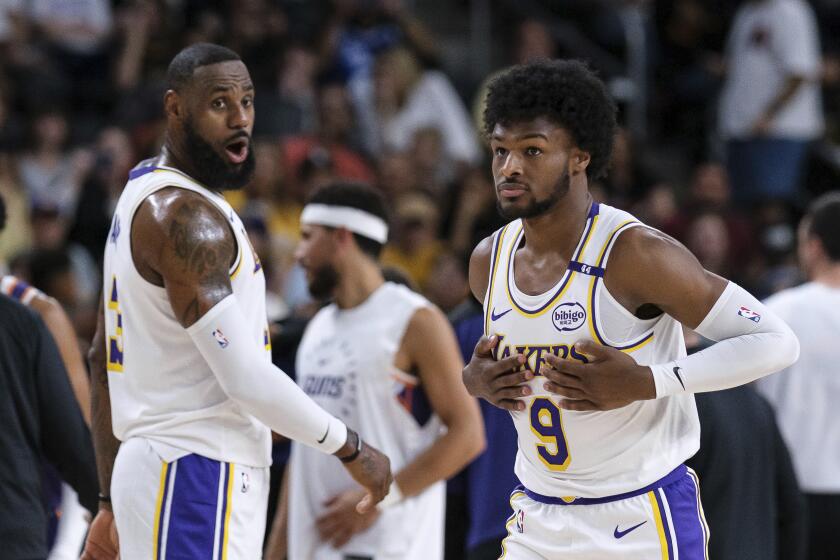Now They’re the Bullies on the Block
Iowa Coach Kirk Ferentz calls it scar tissue. Not the physical kind. The mental kind.
The kind of scars Ferentz worried would be inflicted on his offensive linemen when, out of necessity, they were thrust into starting roles as unprepared freshmen.
Bruce Nelson could have been one of the casualties. A walk-on tight end, he played left tackle in his first start as a redshirt freshman in Iowa’s 1999 opener against Nebraska, then the nation’s top-ranked team. He weighed 250 pounds.
Nebraska won, 42-7, and on every play Nelson said he asked himself the same question: “Why am I out here?”
No one asks that anymore. Today, Nelson is a 6-foot-4, 290-pound All-American center on an experienced offensive line that many consider the best in the nation.
His growth as a player has mirrored that of his linemates -- senior guards Eric Steinbach and Andy Lightfoot, senior tackle David Porter and junior tackle Robert Gallery. They have plenty of war stories, but the battle scars have healed with the help of an 11-1 record and berth in Thursday’s Orange Bowl against USC.
“The great thing about being a veteran group this year is that we’ve been through the highs and lows,” said Steinbach, a 6-7, 290-pound All-American. “Most of us were out there starting as redshirt freshmen, 250 pounds soaking wet.
“I think it’s a huge reason why we’ve been successful, because we played together on those 1-10 and 3-9 teams.”
Those were Iowa’s records in 1999 and 2000, the first two seasons with Ferentz as coach. Defections and injuries among offensive linemen gave Ferentz little choice than to play underclassmen and hope for the best.
“When we got here the cupboard was a little depleted,” Ferentz said. “We were forced to look at some guys who probably weren’t ready to play at that level at that point, but we had no choice.
“The most impressive part about guys like Bruce Nelson and Eric Steinbach is that they’ve been so resilient. They didn’t let the tough times discourage them; they used it to their advantage. They’ve really fought back to have great careers here. It’s been very gratifying to see that happen.”
The transformation of the offensive line from sieve to siege was four years in the making.
In 1999 and 2000, the Hawkeyes ranked last in the Big Ten Conference in rushing offense. Last season, when they finished 7-5 and played in the Alamo Bowl, they ranked sixth.
This season, behind a line that averages 6-6 and 296 pounds, Iowa moved to second in conference rushing at 222.1 yards a game.
Before they got physical, though, the linemen regularly took their lumps.
Nelson said one of the good things about making his first start against then-No. 1 Nebraska was that he knew things couldn’t get any worse.
“It was like a nightmare,” he said. “They were a great team and we had a lot of growing up to do.... I wasn’t prepared. I wasn’t ready to be playing, but the situation called for somebody.”
Like Nelson, Steinbach came to Iowa expecting to play tight end. When coaches initially approached him about moving to the offensive line as a redshirt freshman in 1999, he resisted.
“I thought I could come here and play tight end for four years,” Steinbach said. “Finally, when Coach Ferentz asked me for the second time, I agreed and said, ‘Maybe this might be the smart move.’ I can say that it was. I have no regrets.”
Steinbach played guard in his first start, a 41-11 loss to Ohio State in Iowa’s eighth game of 1999. He weighed 250 pounds, 40 fewer than he does now.
Lightfoot, another fifth-year senior, said the weekly beatings -- on the scoreboard and in the trenches -- caused the young linemen to consider their options.
“At the beginning, we were all ready to quit,” said the 6-6, 285-pound Lightfoot. “It was about to kill us. But for some reason, we stuck it out.”
Nelson said they leaned on Ferentz and offensive line coach Joe Philbin for support through the tough times.
“And they proved to be pretty good rocks for us,” Nelson said.
Along the way, many adjustments had to be made. Gallery played his first four games at tight end as a freshman in 2000. Because of injuries, coaches asked him to move to tackle, a position he had never played.
“It was a big change for me,” said Gallery, a 6-7, 300-pounder who was selected All-Big Ten. “It took me a good year and a half to get comfortable with the things that you have to do as an offensive lineman.”
Gallery credited the seniors for showing him the ropes.
“Those older guys did a great job of teaching me on the go and really helping me out the last few years,” he said.
Few seniors on the Iowa roster carry the respect of backup guard Ben Sobieski. He started one game in 1997 as a true freshman, then started all 11 games as a sophomore. But a series of injuries, including surgeries on each shoulder that caused him to sit out the 1999 and 2000 seasons, derailed a promising career.
Sobieski was granted a rare sixth year of eligibility based on a medical hardship.
“I think he’s one of the great success stories on our team,” Ferentz said of Sobieski. “I really questioned if he would be able to make it through two-a-days this year. There was no way I could envision him going through practice every day, but he did it.”
Sobieski has played in all 12 games, contributing to a line that has given up only 11 sacks.
Years from now, it’s easy to envision this group of offensive linemen getting together and reminiscing about how they survived the 1-10 season of 1999, when Nelson and his linemates learned the hard way on the job.
“The beauty of that year is that it makes this year so much better,” Nelson said. “We know how bad it can be and we know how good it can be.
“And this is as good as it gets.”
More to Read
Go beyond the scoreboard
Get the latest on L.A.'s teams in the daily Sports Report newsletter.
You may occasionally receive promotional content from the Los Angeles Times.










